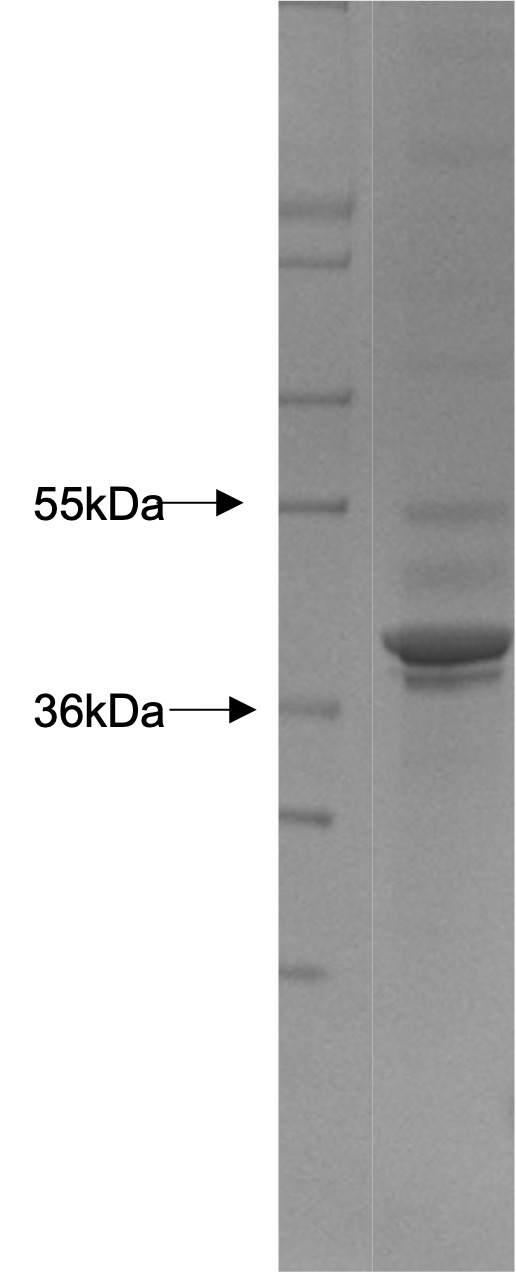Recombinant Human TRAIL/TNFSF10/CD253 (Val114-Gly281, C-6His)(Discontinued)
Shipping Info:
For estimated delivery dates, please contact us at [email protected]
| Amount : | 50 µg |
| Content : | Lyophilized from a 0.2 µm filtered solution of 20mM PB,150mM NaCl,pH7.4. |
| Storage condition : | Lyophilized protein should be stored at -20°C, though stable at room temperature for 3 weeks. Reconstituted protein solution can be stored at 4-7°C for 2-7 days. Aliquots of reconstituted samples are stable at -20°C for 3 months. |
| AA sequence : | MVRERGPQRVAAHITGTRGRSNTLSSPNSKNEKALGRKINSWESSRSGHSFLSNLHLRNGELVIHEKGFYYIYSQTYFRFQEEIKENTKNDKQMVQYIYKYTSYPDPILLMKSARNSCWSKDAEYGLYSIYQGGIFELKENDRIFVSVTNEHLIDMDHEASFFGAFLVGLEHHHHHH |
Source: E. coli.
MW :20.6kD.
Recombinant Human TNF-related Apoptosis-inducing Ligand is produced by our E.coli expression system and the target gene encoding Val114-Gly281 is expressed with a 6His tag at the C-terminus. Human TNFSF10 is a type II transmembrane protein with an intracellular N-terminus and a ‘TNF homology domain’ (THD) at the extracellular C terminus. TNFSF10 can interact with several distinct receptors. Two of these receptors that belongs to TNFR superfamily, DR4 (TRAIL-R1) and DR5 (TRAIL-R2/TRICK2), are plasma membrane proteins containing intracellular death domains essential for activating apoptosis. TNFSF10 is promising for cancer therapy because it is cytotoxic and activates apoptosis in the majority of malignant cells, but not in normal cells.
MW :20.6kD.
Recombinant Human TNF-related Apoptosis-inducing Ligand is produced by our E.coli expression system and the target gene encoding Val114-Gly281 is expressed with a 6His tag at the C-terminus. Human TNFSF10 is a type II transmembrane protein with an intracellular N-terminus and a ‘TNF homology domain’ (THD) at the extracellular C terminus. TNFSF10 can interact with several distinct receptors. Two of these receptors that belongs to TNFR superfamily, DR4 (TRAIL-R1) and DR5 (TRAIL-R2/TRICK2), are plasma membrane proteins containing intracellular death domains essential for activating apoptosis. TNFSF10 is promising for cancer therapy because it is cytotoxic and activates apoptosis in the majority of malignant cells, but not in normal cells.
Endotoxin : Less than 0.1 ng/µg (1 IEU/µg) as determined by LAL test.
For Research Use Only. Not for use in diagnostic/therapeutics procedures.
| Subcellular location: | Cell membrane, Secreted |
| Post transnational modification: | Tyrosine phosphorylated by PKDCC/VLK. |
| Tissue Specificity: | Widespread; most predominant in spleen, lung and prostate. |
| BioGrid: | 114280. 20 interactions. |
|
There are currently no product reviews
|

























.png)









